The ASUS ROG Strix GL502VS Review: Mainstream GTX 1070 with G-SYNC
by Brett Howse on December 9, 2016 8:00 AM ESTSystem Performance
At this point the Skylake mobile quad-core parts are pretty well known. The review unit is outfitted with the Intel Core i7-6700HQ, which is a 45-watt 2.6-3.5 GHz CPU. It has been the staple of almost all quad-core notebooks this year. Also the review unit is outfitted with just a single stick of 16 GB DDR4-2133 memory, which will hamper performance a bit over a dual-channel setup in some of the more varied tests such as PCMark. It’s not quite as critical though on a notebook with a dedicated GPU, but still it would be nice to see 2x8 GB rather than 1x16 GB, unless you wanted to upgrade, in which case the single 16 GB is likely the better choice.
The ASUS GL502VS was put through our standard notebook workflow, which includes a variety of tests to stress different aspects of the device. Several other similar models are used as a comparison, but if anyone wants to compare the GL502VS to any other notebook we’ve tested, please use our online bench.
PCMark
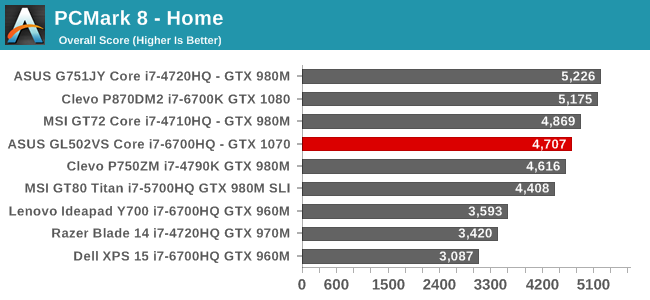

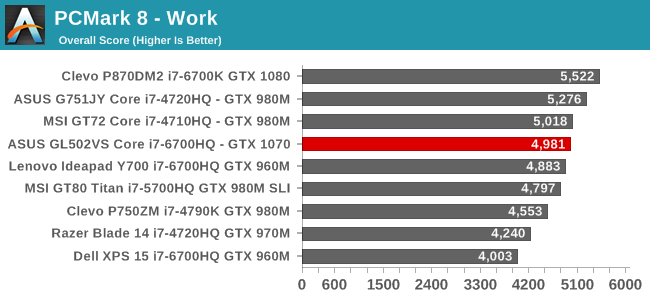
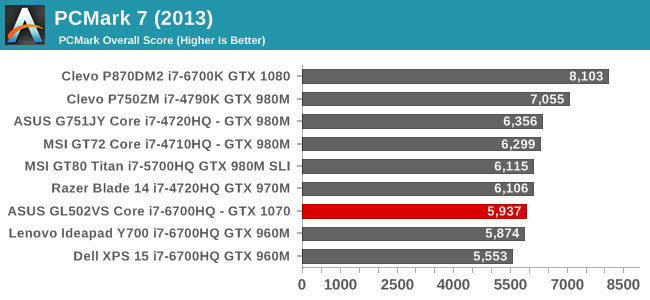
PCMark from FutureMark is a comprehensive system test, which runs through a variety of workloads based on the test chosen. All aspects of the machine impact the final results, including GPU, CPU, memory, drive speed, and even display resolution. The ASUS scores very well here, despite single channel memory performance. The Creative score is quite strong thanks to the much more powerful GPU than previous generation notebooks.
Cinebench

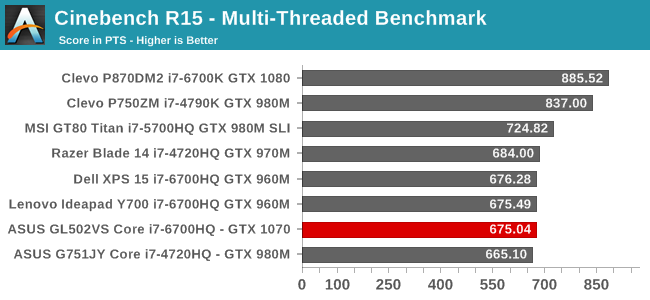
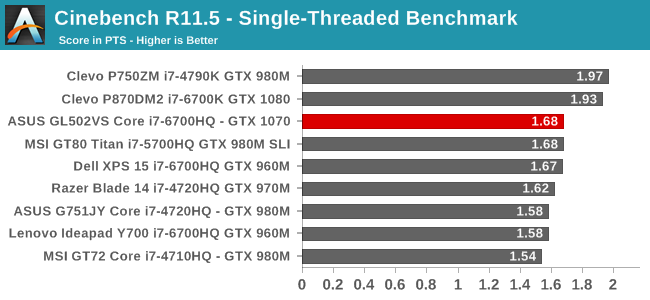
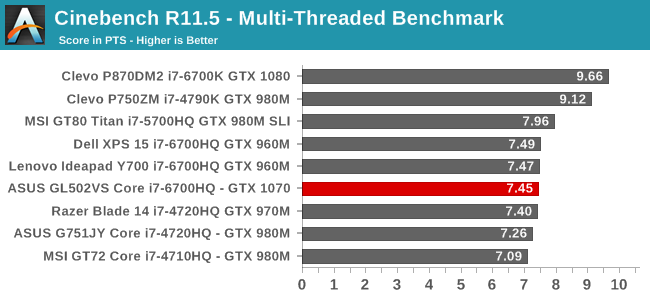
Cinebench is a rendering program which is a pure CPU test. More cores and a higher frequency can pay big dividends on this test. The i7-6700HQ is right in line with other devices with the same CPU.
x264
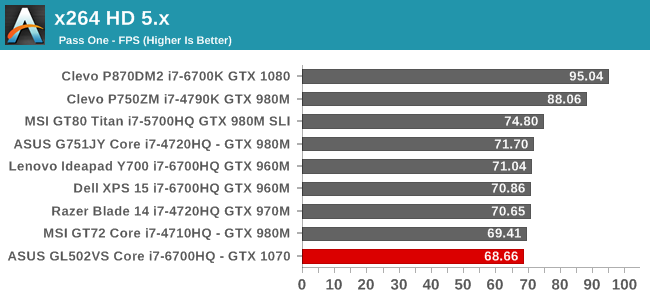
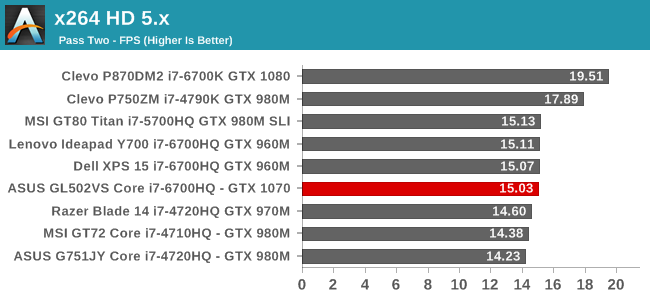
Like Cinebench, this test is mostly a CPU bound test, and once again, the ASUS falls in-line with the other quad-core notebooks featuring this CPU. The desktop class CPUs in the Clevo notebooks have a large advantage on these tests.
Web Tests
The browser is likely the most used application on any computer, and as such browser performance is always important. We’ve moved to Microsoft Edge as the browser with the release of Windows 10, and like Google Chrome and other browsers, the performance of the scripting engine generally improves over time. Each browser performs better on some tasks than others, so these tests have the browser used on each unit pointed out in the results.
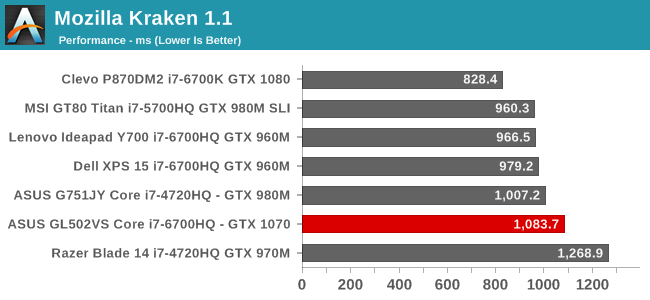
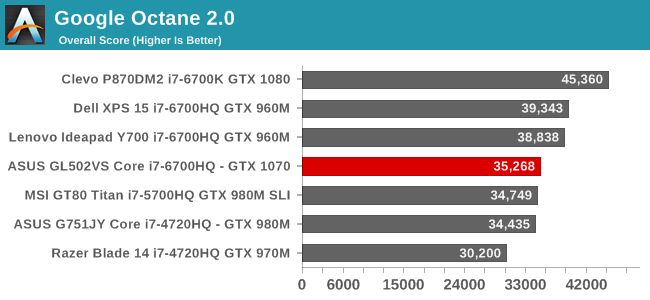
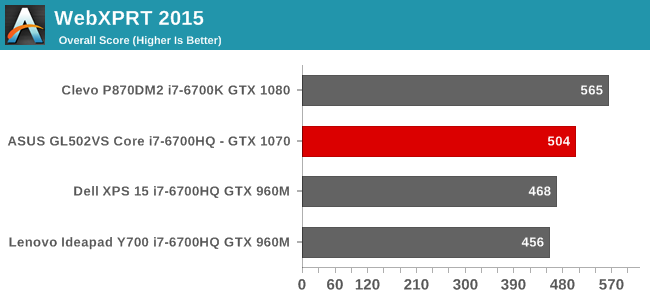

The i7-6700HQ continues to be a strong performer in these tests. The desktop i7-6700K in the Clevo P870DM2 is much quicker, but it’s also a 95-Watt CPU.
Storage Performance
There has been a big push the PCIe based storage over the last twelve months, and ASUS has definitely been at the forefront of that movement. But as we know, not all NVMe drives are the same. NAND capacity is always a factor, and of course TLC or MLC can be a big impact, especially on write speeds where TLC struggles. The ASUS review unit shipped with the Samsung SM951 SSD, which is (unusually for this level of device) an MLC drive. This was already hinted at earlier, but ASUS saved some money on the design of this notebook, but they continue to pack in quality hardware inside, and the use of the SM951 has to be commended since it’s unfortunately very rare to see over the TLC based PM951.
Being just the 256 GB version, the fewer NAND dies compared to the larger capacity models is really the only issue with performance, but it performs very well regardless. Even random read and write speeds are quite strong.
It’s great to see this drive in what would otherwise be considered a budget laptop. Too many laptops, even much more expensive than this one, ship with TLC drives, which are fine, but when you are paying a premium you should expect better.


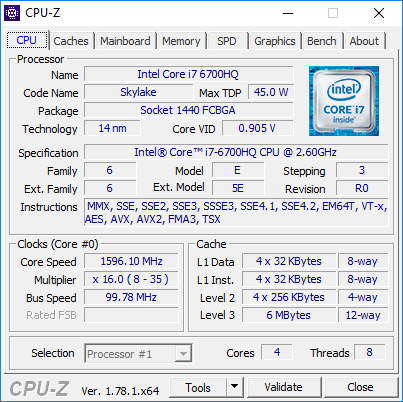
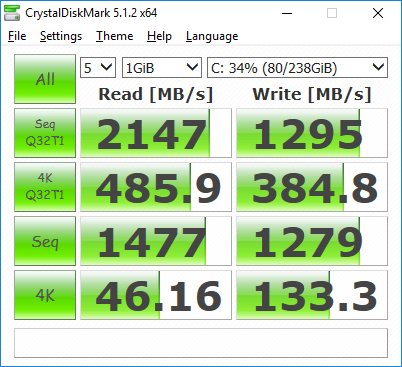








54 Comments
View All Comments
milkod2001 - Friday, December 9, 2016 - link
$1600 is not mainstream by all means but it has very decent specs that that price. It should last at least 3 years no probs. The only thing i would want to change is screen size, should have been 17''.Brett Howse - Sunday, December 11, 2016 - link
They do sell the GL702VM as a 17.3-inch model, but only with GTX 1060. ASUS has the GTX 1070 and up in the G752 which is a nice machine.BrokenCrayons - Friday, December 9, 2016 - link
Mainstream is different for everyone, but I agree that even on the low-end of its price spectrum that this laptop is absolutely not mainstream. However, I understand when you're a writer you're compelled to throw something out there that ultimately can end up the subject of unforseen debate. Let's try not to get overly hung up on it since, really, its as unimportant as calling a penguin a fish. The only thing that's changed is the label. Nothing fundamental about the squishy inside bits of the penguin are made different in doing so.SharpHawk - Friday, December 9, 2016 - link
No thermal data on the CPU?shelbystripes - Friday, December 9, 2016 - link
I got the GL502VM on sale from Amazon for a ridiculous $899 on Black Friday. At that price it's an utterly amazing system, and even at regular price is one of the cheapest Nvidia 10-series systems around, though I have some comments about its performance that this article fails to mention. The article makes it seem like it's just a GL502VS with a 1060 instead of a 1070, and that's not the case:1) The GL502VM doesn't come with G-Sync. At least, the lower end models don't.
2) The base model uses a quad-core i5, which is slightly slower, but more importantly lacks hyperthreading. I've found HT to historically not make a huge difference, but it's worth noting.
2) The GL502VM comes with 8GB RAM soldered on. It has one SODIMM slot, so if you buy a 16GB model it includes one 8GB DIMM plus the soldered-on RAM. Max memory capacity is limited to 24GB, since you can't swap out one channel of 8GB for 16GB later.
3) The GTX 1060 inside is the 3GB model, which actually has not just less RAM but fewer cores than the 6GB model. Still sufficient for 1080p gaming in a lot of games, especially for a budget gaming laptop, but worth noting it's about more than just the RAM. (I'm not sure if there's a similar discrepancy between the 4GB and 8GB GTX 1070 models available in the GL502VS, but at least you can get the higher end model there.)
4) This is really a comment on both machines, but the base models come with a mechanical HDD only. There's still an M.2 slot in the base models, it's just unpopulated. Still, I snagged a cheap 2.5" SATA SSD on Black Friday, and just a little simple surgery (not difficult, but 10 screws just to open it up, plus 8 screws for the HDD mount!) later, I had a MUCH faster system than I would have otherwise.
And lastly, a general tip when self-upgrading to save money: Windows 10 doesn't come with activation keys, it syncs your system unique ID to your Microsoft account. Microsoft made clean-installing Windows 10 much easier, you can download a tool from Microsoft's website to make a Windows 10 USB installer, but you'll need to boot the system at least once on the mechanical HDD to activate the copy of Windows 10 it comes with and link it to your Microsoft account. Then you can yank the HDD, swap in an SSD, and do a clean install (even if you're adding an M.2 SSD and keeping the HDD, you may want to do a clean install onto the SSD to get rid of the crapware anyway) without any problem. Just log into your Microsoft account during the reinstall and it'll recognize you have a Windows 10 license for that device. If (like me) you were clinging to Windows 7 on your last machine, I figure this knowledge might be new and useful to you.
sundragon - Friday, December 23, 2016 - link
Thank you! I may do this on my 502VS.label47 - Friday, December 9, 2016 - link
If you play heavy games the Battery will drain while plugged in...https://rog.asus.com/forum/showthread.php?88742-GL...
jsntech - Friday, December 9, 2016 - link
Yikes. Wonder what happens when it gets down to 0%? The ASUS rep responding to one of the bunches of people with the same complaint is unfortunate: " I've PM you a message, please check your inbox, thank you". Like they're trying to run interference instead of just openly acknowledging and working with customers. "Support" like that is one of the reasons I am hesitant to go with ASUS and others like them (though the bigger players are no better...sigh).kvnobrien - Friday, December 9, 2016 - link
"ASUS would have much better battery life if it just had a bigger battery" - quote of the year. Thank you this made me chuckle. I get the point you were trying to make it's just funny though.marco89nish - Friday, December 9, 2016 - link
I fail to see usefulness of G-Sync on 60Hz 1080p display with GTX 1070. It should be very challenging to drop 1070 to under 60 fps in next few years. Adding 75/90/120Hz display instead of G-Sync would yield much better value in my opinion.